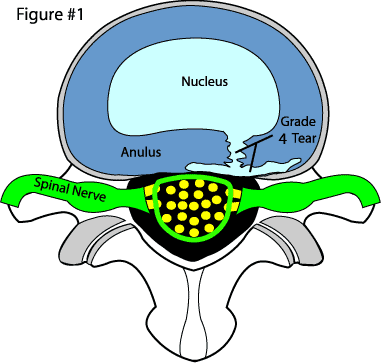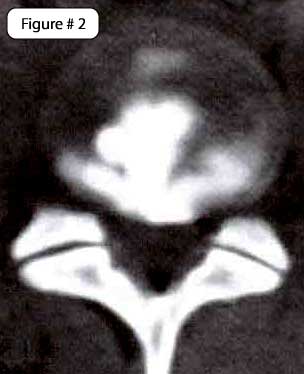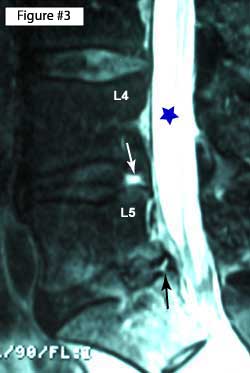Radial Tears | Rim Lesions | Concentric Tears | Anular Tear Home
HIZ: High Intensity Zone
 HIZ
is an MRI 'finding' that is sometimes (37%) is seen on the T2 weighted
study of back pain sufferers. This phenomenon is only seen in the lumbar
spine and NOT seen in the thoracic or cervical spine. When present,
the sign is high indicative that the disc will have a grade 4 disc anular
disruption. Figure #1, is a refresher of what grade
4 IDD looks like as viewed from over-head (axial view). Note the back
of the anulus is completely torn through and has leak nuclear material
into a large concentric anular tear. So, as you can see an HIZ sign
is really two types of anular tears in one; the 'radial tear', and the
'concentric tear'.
Some believe that HIZ is strongly indicative of that disc being a 'pain
generator' (responsible for your back pain). The latter theory is controversial
as you will see below.
HIZ
is an MRI 'finding' that is sometimes (37%) is seen on the T2 weighted
study of back pain sufferers. This phenomenon is only seen in the lumbar
spine and NOT seen in the thoracic or cervical spine. When present,
the sign is high indicative that the disc will have a grade 4 disc anular
disruption. Figure #1, is a refresher of what grade
4 IDD looks like as viewed from over-head (axial view). Note the back
of the anulus is completely torn through and has leak nuclear material
into a large concentric anular tear. So, as you can see an HIZ sign
is really two types of anular tears in one; the 'radial tear', and the
'concentric tear'.
Some believe that HIZ is strongly indicative of that disc being a 'pain
generator' (responsible for your back pain). The latter theory is controversial
as you will see below.
High Intensity Zone (HIZ): A replacement for Discography?
 To
date our number one tool for diagnosing discogenic pain is provocative
discography. Although discography has its limitations (especially in
patients with psychological overlay ), most surgeons will not perform
disc surgery until the suspect disc is tested via provocative discography.
The problem with discography is that not only is it an extremely painful
test - in fact the more pain your get, concordantly, the more positive
the test is. Figure #2 denotes a real Grade 4 disruption
as seen on discography. Compare this to figure #1 if you need orientation.
Discography is also potentially dangerous for the development of discitis,
cerebral spinal fluid leakage, retroperitoneal bleeding, and acute new
back pain (especially in patients with somatization disorder - ie. 66%
(37)) does rarely occur, not to mention the tremendous radiation exposure
to the patient (If CT is used).
To
date our number one tool for diagnosing discogenic pain is provocative
discography. Although discography has its limitations (especially in
patients with psychological overlay ), most surgeons will not perform
disc surgery until the suspect disc is tested via provocative discography.
The problem with discography is that not only is it an extremely painful
test - in fact the more pain your get, concordantly, the more positive
the test is. Figure #2 denotes a real Grade 4 disruption
as seen on discography. Compare this to figure #1 if you need orientation.
Discography is also potentially dangerous for the development of discitis,
cerebral spinal fluid leakage, retroperitoneal bleeding, and acute new
back pain (especially in patients with somatization disorder - ie. 66%
(37)) does rarely occur, not to mention the tremendous radiation exposure
to the patient (If CT is used).
Science has been searching for a less invasive way to confirm the presents of discogenic pain.
In 1992, Aprill & Bogduk published
a stunning paper, in which they claimed that 'High Intensity Zones'
(HIZ), as visualized on T2 weighted MRI’s, were 90% predictive
(PPV) that the disc will show a grade 4 disruption on discography. (The
latter claim is very true and not contested.) They also claimed that
90% of these HIZ signs would test positive for concordant pain on provocative
discography and that 82% of all concordant discs tested on provocative
discography will have a HIZ sign on MRI (this is called the sensitivity).
This data was based on 500 consecutive MRI’s of patients with
lower back pain bad enough to warrant an MRI; 143 HIZ were discovered
(7). Figure #3 is a perfect example of an HIZ
sign (white arrow) in the posterior of my L4 disc. By
Bogduk's definition, the HIZ must be as intense (white) as the adjacent
CSF (blue star). Bogduk also theorized that 'Low Intensity Zones' or
LIZ (black arrow) were representative of 'unsymptomatic' and "less
inflamed" anular tears. He believed that LIZ would be seen in asymptomtic
people (38). (He was proved wrong in this respect by Carragee (16)).
Bogduk and Aprill believed, as others have confirmed, that the HIZ was
the combination of a concentric and radial anular tear that had merged within the periphery of the disc. They proposed that
the ‘tell-tale brightness’ of the HIZ was from trapped nuclear
material between the lamellae in the periphery which has resulted in
an inflammatory reaction. This inflammation (which shows very brightly
on MRI) is what gives the HIZ a higher intensity than the nucleus. Recently,
animal studies and 'in vivo' studies (20) have proposed that vascularized
granulation in growth into the peripheral anular tear is what causes
the HIZ's 'brightness' and not
just simple inflammation. Bogduk & Aprill concluded their paper
by saying, “HIZ is the first sign evident on MRI that has been
shown to be diagnostic for low-back pain.” (7)
that had merged within the periphery of the disc. They proposed that
the ‘tell-tale brightness’ of the HIZ was from trapped nuclear
material between the lamellae in the periphery which has resulted in
an inflammatory reaction. This inflammation (which shows very brightly
on MRI) is what gives the HIZ a higher intensity than the nucleus. Recently,
animal studies and 'in vivo' studies (20) have proposed that vascularized
granulation in growth into the peripheral anular tear is what causes
the HIZ's 'brightness' and not
just simple inflammation. Bogduk & Aprill concluded their paper
by saying, “HIZ is the first sign evident on MRI that has been
shown to be diagnostic for low-back pain.” (7)
Aprill & Bogduk’s results were confirmed by: Schellhas et al. in 1996, whom noted an 87% PPV for 100 HIZ’s for concordant pain on discography (15); Lam et al. in 2000, whom noted an 89% PPV for 92 HIZ’s for pain on discography (20); and Saifuddin et al. in 1998, whom noted 89% PPV for 27 HIZ’s for concordant pain, although they noted a low sensitivity (27%); meaning that not all the painful discs will have an HIZ sign (35).
HIZ’s found in Asymptomatic Patients: Bogduk Bashing!!
The HIZ theory has been high controversial. A large group of researchers could not confirm his work (16, 18, 34, 35, 36), although some very large studies have (15,19,20). Especially note worthy is the '2000 Volvo Award' winning paper by Stanford’s Eugene Carragee et al. They found that 24% of "asymptomatic individuals', that were the same age and had the same spinal conditions as the symptomatic groups, had HIZ signs despite being completely asyptomatic. Of this 24%, 70% of the discs were painful on provocative discography! 70% of the symptomatic discs were also painful on discography. Both the asymptomatic and symptomatic patients had the same magnitude of pain on discography! This finding not only attacks Aprill and Bogduk, but also attacks the reliability of Discography in general! The fact that many of the 'asymptomatic' participants were past cervical and lumbar surgical candidates probably had something to do with these crazy findings. This famous skeptic did confirm that these HIZ signs were very strongly related (95%) to that disc having a grade 3 or 4 radial fissure (16), but he strongly doubted that HIZ signs were predictive of the affected disc being a true pain generator. Thus Bogduk's HIZ theory was seriously damaged, although Bogduk never claimed that HIZ was worth 'anything' if seen in asymptomatic patients. HIZ only applies to someone having back pain.
My beef with these 'damaging' studies is that the “asymptomatic patients” used in there's studies were not your normal everyday guy off the street, but instead were groups of patients that had already suffer significant spinal pain syndrome including groups of past spinal surgery patients! Of the papers I have studied – including Carragee’s Volvo Award winner in 2000 – the authors “asymptomatic patient groups” were composed of people who: #1) Have had prior lower back pain and sciatica before, but claimed that were now had been pain free for a whole 6 months (18), #2) Have had previous neck surgery – some still suffering chronic neck pain (18, 16), #3) Have had previous “very successful low back surgery”, but now have been pain free of 12 months (16)!
Boy, if that’s not ‘stacking the deck’ in favor of destroying the validity of HIZ, I don’t know what is, especially given what we now know about the huge role that genetics plays in determining disc strength and the tendency to herniate. All of these so called asymptomatic patients would be high risk for back problems, disc herniations, and disc tears in the first place. It’s certainly not surprising too me that a group of past spinal surgery patients would demonstrate false positives on MRI and discography! I would like to see a large group of ‘normal people’, who have not had any prior spinal problems of any kind, be tested for ‘false HIZ’, false disc herniation, and falsely positive discography. I’m almost certain that the results of Carragee’s experiments would be much different, and much more supportive of Bogduk. I still can't understand why they gave him the Volvo Award for this?
Bogduk’s book (2002) he fired back at all the researchers who proposed - the HIZ was invalid because it was also seen in asymptomatic patients by saying that; “HIZ was never promoted as an unqualified sign of back pain. This sign does not discriminate between patients with and without back pain.” When HIZ is present in a symptomatic patient, then “the affected disc is the source of the patient’s pain, and predicts that the disc will have internal disc disruption with a grade III or grade IV fissure (13)”.
So there you have it. If you have HIZ on your MRI, you can bet your bottom dollar that your disc has at least a grade 3 anular tear in it and probably a grade 4. Whether or not its a pain generator must still be decided with provocative discography, for there is too much doubt over whether or not HIZ indicates discogenic pain.
Radial Tears | Rim Lesions | Concentric Tears | Anular Tear Home
References:
7) Aprill C, Bogduk N, "High Intensity Zone" - The Brit Jour Radio 1992; 65, 361-369
13) Bogduk N, McGuirk B, "Medical Management of Acute & Chronic Low Back Pain" Elsevier 2002; 13:135-137
15) Schellhas KP, et al. "Lumbar Disc High-intensity Zone - MRI & Discography" - Spine 1996; 21:79-86
16) Carragee EJ, et al. "2000 Volvo Award - HIZ & Discography in without Low Back Problems" - Spine 2000; 25(23):2987-2992
18) Stadnik TW, et al. "Annular Tears & Disc Herniations:... Absent Low Back Pain" - Neuroradiology 1998; 206:49-55
19) Ito M, et al. "Predictive signs of discogenic lumbar pain on MRI with Discography correlation." - Spine 1998; 23:1252-8
20) Lam KS, et al. "Lumbar disc High-Intensity Zone: the Value & Significants of provocative discography for discogenic pain" - Eur Spine J 2000; 9:36-41
34) Ricketson R, "The High-Intensity Zone with Discography Correlation." Spine - 1996; 21:2758-2762
35) Saifuddin A, "The Value of Lumbar Spine MRI in the Demonstration of Anular Tears." Spine - 1998; 23:453-457
36) Smith B, "Interobserver Reliability of Detecting Lumbar Intervertebral Disc High-Intensity Zone on Magnetic Resonance Imaging and Association of High-Intensity Zone With Pain and Anular Disruption." Spine - 1998; 23:2074-2080
37) Zucherman J, Derby R, Hsu K, et al. Normal magnetic resonance imaging with abnormal discography. Spine 13:1355--9, 1988.
38) Bogduk N, 'Point of View' - Spine 1998; 23:1259-1260
© Copyright 2002 – 2005 by Dr. Douglas M. Gillard DC - All rights reserved